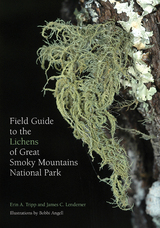3 books about Great Smoky Mountains National Park

Field Guide to the Lichens of Great Smoky Mountains National Park
Erin Tripp
University of Tennessee Press, 2020
With 909 recognized species of lichens, Great Smoky Mountains National Park (GSMNP) is home to more of these lichenized fungi than any other national park in the United States, as well as nearly half of all species known to occur in eastern North America. There is a great deal of room for scientific exploration, inquiry, and systematic description in the realm of lichenology. In Field Guide to the Lichens of Great Smoky Mountains National Park, Erin Tripp and James Lendemer take on the formidable task of creating an all-in-one resource for Park exploration, including lichen distribution maps, tools for identification, vivid photographs and illustrations, and even field notes from their own research campaigns. In the process, the authors create a touchstone for lichen taxonomy and ecology, and they inspire others—researchers as well as casual observers—to take interest in the incredible biodiversity of the Great Smoky Mountains. Biologists, botanists, visitors to the park, naturalists, and others interested in the flora and fauna of both the southern Appalachians and GSMNP will thoroughly enjoy this lovingly prepared field guide.
[more]

Mammals of Great Smoky Mountains National Park
Donald W. Linzey
University of Tennessee Press, 2016
Visitors to Great Smoky Mountains National Park are likely to see a variety of wildlife, from the small and difficult to observe to the large and spectacular. A wide assortment of animals— salamanders, turtles, lizards, snakes, birds, deer, and bears—inhabit the park. Mammals of Great Smoky Mountains National Park focuses on the park’s fur-bearing animals that nurse their young.
The first edition of Mammals of Great Smoky Mountains National Park was published in 1971, and significant changes have transpired in the past forty-five years: new species have been discovered in the park, reintroductions—some successful and one unsuccessful—have occurred, and a number of taxonomic revisions have taken place. This updated edition contains accounts of seventy-two of the park’s mammals, including opossums, shrews, moles, bats, rabbits, rodents, wolves, raccoons, pumas, and other carnivores and deer and elk.
Donald W. Linzey, who began working in the park in 1963, draws on his extensive research background and combines it with the notes of Arthur Stupka, former chief naturalist and park biologist, and many others who have contributed to knowledge of the mammals in the park. Several new features have been added to the third edition, including the origins of genus and species names, photographs of new species, and skull drawings of some species, which illustrate distinct features. To honor the park’s Cherokee heritage, the Cherokee names for many mammals are now given along with their English names.
Written for laymen and biologists alike, Linzey discusses the distribution, habitat, food habits, predation, and reproductive habits of mammals ranging from the pigmy shrew to the conspicuous black bear.
DONALD W. LINZEY, a professor of biology at Wytheville Community College in Wytheville, Virginia for twenty-four years, is currently a faculty member in the Department of Fish and Wildlife Conservation at Virginia Tech in Blacksburg, Virginia. Among many other books, he is the author of A Natural History Guide to Great Smoky Mountains National Park.
The first edition of Mammals of Great Smoky Mountains National Park was published in 1971, and significant changes have transpired in the past forty-five years: new species have been discovered in the park, reintroductions—some successful and one unsuccessful—have occurred, and a number of taxonomic revisions have taken place. This updated edition contains accounts of seventy-two of the park’s mammals, including opossums, shrews, moles, bats, rabbits, rodents, wolves, raccoons, pumas, and other carnivores and deer and elk.
Donald W. Linzey, who began working in the park in 1963, draws on his extensive research background and combines it with the notes of Arthur Stupka, former chief naturalist and park biologist, and many others who have contributed to knowledge of the mammals in the park. Several new features have been added to the third edition, including the origins of genus and species names, photographs of new species, and skull drawings of some species, which illustrate distinct features. To honor the park’s Cherokee heritage, the Cherokee names for many mammals are now given along with their English names.
Written for laymen and biologists alike, Linzey discusses the distribution, habitat, food habits, predation, and reproductive habits of mammals ranging from the pigmy shrew to the conspicuous black bear.
DONALD W. LINZEY, a professor of biology at Wytheville Community College in Wytheville, Virginia for twenty-four years, is currently a faculty member in the Department of Fish and Wildlife Conservation at Virginia Tech in Blacksburg, Virginia. Among many other books, he is the author of A Natural History Guide to Great Smoky Mountains National Park.
[more]

A Roadside Guide to the Geology of Great Smoky Mountains National Park
Mountains National Park
Harry L. Moore
University of Tennessee Press, 1988
Guiding the reader on five popular driving tours and five key hiking trails, this nontechnical guidebook indicates not-to-be-missed points of interest and describes the geological evolution associated with them. Tour maps are complemented by annotated road log commentaries and copious drawings and photographs to aid in identifying geological phenomena even when these are obscured by the mountains' lush vegetation. A helpful introduction, focusing on the geologic history of the Smokies, illuminates basic terms and concepts, while a glossary, list of suggested readings, and detailed index further enhance the book's utility. Unique in providing a crisp, comprehensive summary of the Smoky Mountains' geology, A Roadside Guide will serve as a basic planning guide for scenic road trips and hiking trips in the Smokies.
[more]
READERS
Browse our collection.
PUBLISHERS
See BiblioVault's publisher services.
STUDENT SERVICES
Files for college accessibility offices.
UChicago Accessibility Resources
home | accessibility | search | about | contact us
BiblioVault ® 2001 - 2024
The University of Chicago Press









